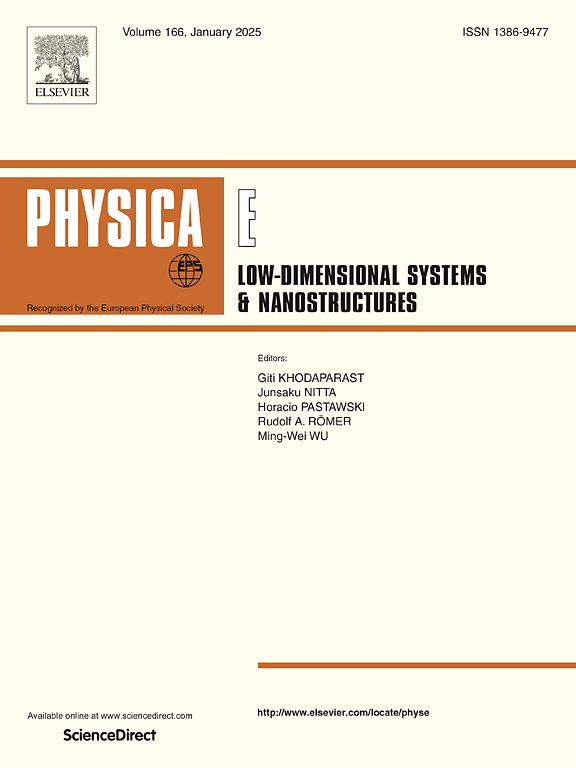Entanglement negativity in non-Hermitian PT-symmetric models
IF 2.9
3区 物理与天体物理
Q3 NANOSCIENCE & NANOTECHNOLOGY
Physica E-low-dimensional Systems & Nanostructures
Pub Date : 2025-04-17
DOI:10.1016/j.physe.2025.116271
引用次数: 0
Abstract
Topological phase transitions are very common in a variety of quantum systems and are a rising topic in actuality. Here we investigate quantum correlation and entanglement in some non-Hermitian -symmetric quantum systems such as Su–Schrieffer–Heeger (SSH) model, which exhibits chiral symmetry and different phases characterized in terms of a topological invariant. The effective Hermitian Hamiltonian has always a higher dimension than the corresponding non-Hermitian model. We verified the effect of periodic hopping modulation on SSH model that exhibits the non-Hermiticity due to presence of an on-site staggered imaginary potential, on measure of quantum entanglement of mixed state given by the entanglement negativity . Since its dissipative non-Hermitian extension modifies the features of the topological trivial phase and topological nontrivial phase, the weak potential respecting the parity-time symmetry () keeps the energy eigenvalues real.
非厄米pt对称模型中的纠缠负性
拓扑相变在各种量子系统中都很常见,是一个新兴的研究课题。本文研究了一些非厄米pt对称量子系统(如Su-Schrieffer-Heeger (SSH)模型)中的量子相关和纠缠,这些量子系统表现出手性对称性和以拓扑不变量表征的不同相。有效厄米哈密顿量总是比相应的非厄米模型具有更高的维数。我们验证了周期跳变调制对SSH模型的影响,该模型由于现场交错虚势的存在而表现出非厄米性,对纠缠负性EN给出的混合态量子纠缠的测量。由于其耗散的非厄米拓延改变了拓扑平凡相和拓扑非平凡相的特征,使得遵从奇偶-时间对称的弱势保持了能量特征值的实数。
本文章由计算机程序翻译,如有差异,请以英文原文为准。
求助全文
约1分钟内获得全文
求助全文
来源期刊
CiteScore
7.30
自引率
6.10%
发文量
356
审稿时长
65 days
期刊介绍:
Physica E: Low-dimensional systems and nanostructures contains papers and invited review articles on the fundamental and applied aspects of physics in low-dimensional electron systems, in semiconductor heterostructures, oxide interfaces, quantum wells and superlattices, quantum wires and dots, novel quantum states of matter such as topological insulators, and Weyl semimetals.
Both theoretical and experimental contributions are invited. Topics suitable for publication in this journal include spin related phenomena, optical and transport properties, many-body effects, integer and fractional quantum Hall effects, quantum spin Hall effect, single electron effects and devices, Majorana fermions, and other novel phenomena.
Keywords:
• topological insulators/superconductors, majorana fermions, Wyel semimetals;
• quantum and neuromorphic computing/quantum information physics and devices based on low dimensional systems;
• layered superconductivity, low dimensional systems with superconducting proximity effect;
• 2D materials such as transition metal dichalcogenides;
• oxide heterostructures including ZnO, SrTiO3 etc;
• carbon nanostructures (graphene, carbon nanotubes, diamond NV center, etc.)
• quantum wells and superlattices;
• quantum Hall effect, quantum spin Hall effect, quantum anomalous Hall effect;
• optical- and phonons-related phenomena;
• magnetic-semiconductor structures;
• charge/spin-, magnon-, skyrmion-, Cooper pair- and majorana fermion- transport and tunneling;
• ultra-fast nonlinear optical phenomena;
• novel devices and applications (such as high performance sensor, solar cell, etc);
• novel growth and fabrication techniques for nanostructures

 求助内容:
求助内容: 应助结果提醒方式:
应助结果提醒方式:


